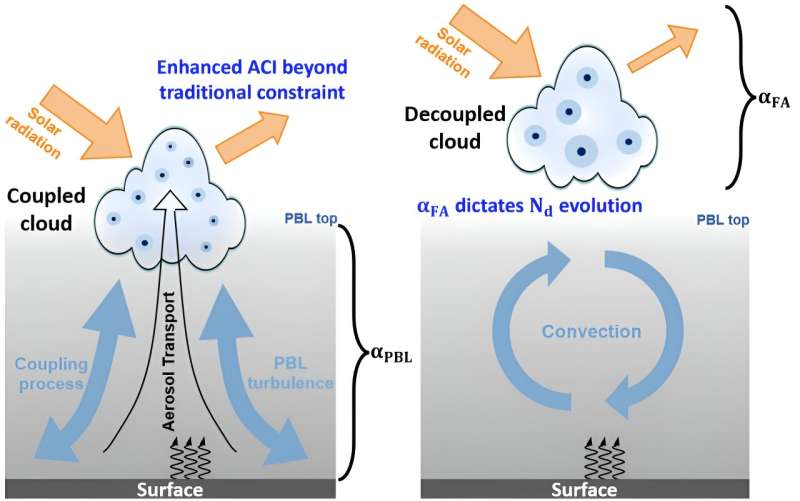This article has been reviewed according to Science X's editorial process and policies. Editors have highlighted the following attributes while ensuring the content's credibility:
fact-checked
peer-reviewed publication
trusted source
proofread
Aerosols may affect climate more than previously thought

A key to improving climate prediction is to improve understanding of the impact of aerosol on clouds, commonly known as the aerosol-cloud-interaction, according to a new study led by Earth System Science Interdisciplinary Center (ESSIC) researchers published in Science Advances.
In the study, the researchers investigated the ways in which clouds interact with aerosols—tiny particles in the air from various sources, like dust, smoke, or pollution from cars and factories. This process, known simply as aerosol-cloud interaction, has been identified as the forefront of climate science by the Intergovernmental Panel on Climate Change (IPCC).
"Aerosol-cloud interaction has remained the largest source of uncertainty in understanding Earth's climate and projecting its future changes, especially those incurred by anthropogenic emissions such as sulfate, nitrate, and black carbon," says Zhanqing Li, Distinguished University Professor at UMD and corresponding author on the paper.
Aerosol particles act as "seeds" around which water vapor condenses to form cloud droplets. When there are more aerosols in the atmosphere, there are more cloud droplets, which can make cloud droplets smaller, clouds thicker, and thus more reflective to incoming solar radiation. For example, after a volcanic eruption, the high number of aerosols in the atmosphere can lead to more clouds forming, resulting in a cooling effect on Earth's climate.
The aerosol-cloud-interaction is affected by cloud-surface coupling, or the ways in which clouds interact with the Earth's surface and its atmospheric boundary layer. Traditionally, studies of aerosol-cloud interactions haven't considered the connection between cloud-surface coupling and aerosol activity.
"Our new approach in this research specifically looks at how this coupling changes the way aerosols impact clouds," explains Tianning Su, who currently works for Lawrence Livermore National Lab in California but conducted this research when he was a Postdoctoral Associate at ESSIC, "It's like checking whether the clouds are 'plugged in' to what's happening on the ground or if they're kind of floating independently."
The researchers found that cloud-surface coupling plays a significant role in aerosol-cloud interactions. As Earth's surface warms the air above it, the air gets lighter and starts to rise. This process acts as a tunnel connecting the clouds with the land surface.
When the "tunnel" is open and active, aerosols can spread to cloud layers and spread evenly across the boundary layer, resulting in more consistent cloud formation and stronger cooling effects. On the other hand, when clouds are decoupled, or when this tunnel is closed, the aerosols can behave in unpredictable ways, leading to varying cloud properties and thus large uncertainties in quantifying the aerosol-cloud-interaction as reported in the IPCC.
This disparity between coupled and decoupled clouds helps explain why climate models and observations often don't align.
"A major reason for not accounting for it in previous studies lies in difficulties in determining the coupling state for continental clouds. This was overcome in our earlier studies, leading to several breakthroughs as featured recently in EOS ... ," says Li.
By accounting for cloud-surface coupling's role in aerosol-cloud interactions, the researchers believe we can get more accurate estimates of how aerosols influence clouds and climate change. Next, the team is interested in seeing how these findings apply on a global scale.
"If we can determine cloud-surface coupling across the globe, we could significantly improve our quantification of aerosol climate effects," says Su, "The goal is to integrate this new understanding into broader climate projections to reduce uncertainty and make more accurate predictions about climate change."
More information: Tianning Su et al, Constraining effects of aerosol-cloud interaction by accounting for coupling between cloud and land surface, Science Advances (2024). DOI: 10.1126/sciadv.adl5044
Journal information: Science Advances
Provided by University of Maryland





















